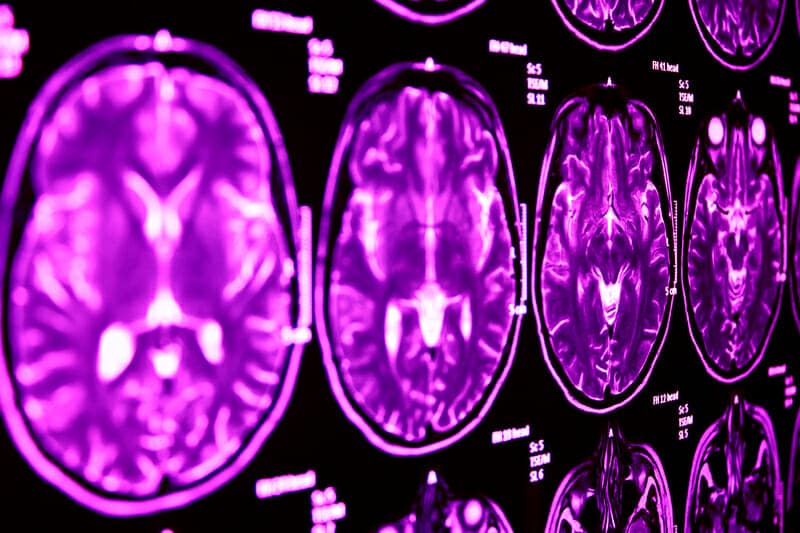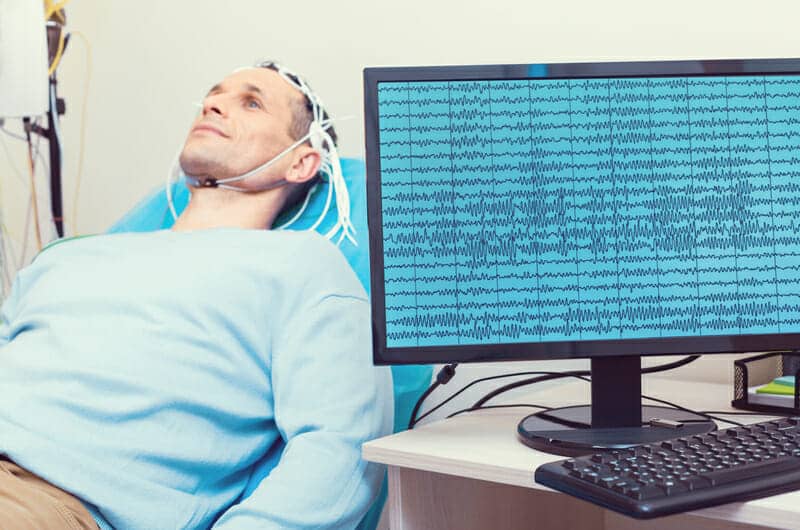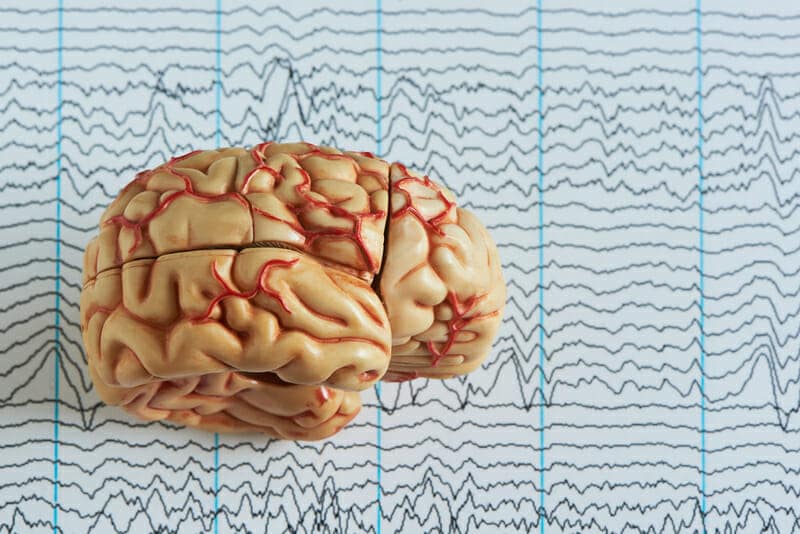Ever see one of those captivating ads on Instagram or Twitter promoting some kind of brain-training software?
An app on your computer or smartphone that promises to sharpen your memory, improve your concentration, and expand your vocabulary?
There’s a giant global market for these “brain fitness” apps, currently sitting at a valuation of $6.52 billion in 2021 and projected to reach $44.4 billion by 2030.
However, all of them are made for your average NPC aka normie who thinks they’re going to get a 20 IQ point boost with just 15 minutes a day.
And we don’t even have anything that will help people who are mentally less fortunate and afflicted with diseases such as ADHD, Parkinson’s, or PTSD.
But Think Interfaces Inc. has come out with something designed to unlock the limitless capacity of our brains using the body’s own natural healing mechanisms.
A groundbreaking technology that not only leads to breakthroughs in mental performance, but also helps people escape from dysfunctional and debilitating mental states.
(And dare I say possibly surpassing the mind-blowing results of RASHA Technology?)
I talked about this technology with its creator, Think Interfaces’ CEO and Founder Dr. Lana Bach-Morrow, in my most recent podcast:
But since this podcast covers the spiritual aspects of mental performance, I wanted to explore the “other side” and dive deeper into the actual science and technology powering her brain-training software.
Why “Brain-Training Games” Do Not Work

In order to truly understand why Dr. Bach-Morrow has created this revolutionary technology for cognitive health, we need to understand the current state of brain-training apps.
The market is effectively over-saturated with thousands of these apps, with a few names sticking out the most due to ludicrous advertising dollars and relentless promotion and social media.
One example would be Elevate, an iOS app currently sitting at 50 million users and a 4.8/5.0 rating from over 250,000 reviews.
Here’s the description taken straight from the Apple App Store, but know that every brain training app is just a rewrite of what I’m quoting.
“Elevate is a brain training program designed to improve your mind’s focus, memory, speaking abilities, processing speed, math skills, and more. Each person is provided with a personalized training program that adjusts over time to maximize results.
The more you train with Elevate, the more you’ll improve critical cognitive skills that are proven to boost productivity, earning power, and self-confidence. 90%+ report improved vocabulary, math skills, and overall mental sharpness when they frequently use Elevate.
…Elevate’s games are designed in collaboration with experts in neuroscience and cognitive learning and are based on extensive scientific research. Elevate’s brain training algorithms further focus the learning experience by drawing from research in memory studies to develop a personalized training program for each user.”
But as scientists are already figuring out, and eventually most consumers, we still don’t know for certain whether these brain-training games ACTUALLY WORK:
“Lack of scientific research is one of the major factors hampering the growth of the market. There are several companies in the market that develop brain training apps with lack of proper research and expert advice, and claims to be effective for cognitive assessment. For instance, in 2016, Lumos Labs agreed to pay US$ 2 million in a settlement with the Federal Trade Commission, which accused the labs of deceiving people with claims that their games could help them get smarter or avoid memory loss.”
And once you remove all the smoke and mirrors that come with marketing to uneducated customers online, the #1 issue facing these apps remains:
You get much better at playing the brain training games themselves, but you do not necessarily improve your overall cognitive function or keep any “gains” you get.
There is a lack of direct transference from the apps toward real life in the form of mastering cognitive tasks we have not yet encountered faster than we usually would.
This was evidently clear as early as 2010, back when brain-training games were in their infancy as a multi-million dollar industry:
“Here we report the results of a six-week online study in which 11,430 participants trained several times each week on cognitive tasks designed to improve reasoning, memory, planning, visuospatial skills and attention. Although improvements were observed in every one of the cognitive tasks that were trained, no evidence was found for transfer effects to untrained tasks, even when those tasks were cognitively closely related.”
“Although we cannot exclude the possibility that more focused approaches, such as face-to-face cognitive training, may be beneficial in some circumstances, we believe that these results confirm that six weeks of regular computerized brain training confers no greater benefit than simply answering general knowledge questions using the internet”
And in a 84-page literature review on brain training games published in 2016, this lack of “transfer of training” is repeatedly seen when you look at the hundreds of studies on the subject of brain fitness:
“For example, performance on inductive and spatial reasoning tasks is moderately correlated (and both are examples of “fluid” abilities), but training in inductive reasoning does not enhance spatial reasoning, nor does training in spatial reasoning enhance inductive reasoning.
The lack of transfer from one content domain to another is also seen in the development of expertise. A person who practices memorizing digits will increase his or her digit span but will be unlikely to show a benefit for color span or letter span.
Chess grandmasters can recall a mid-game chess position with remarkable accuracy after viewing it for only a few seconds, but they show little advantage when remembering other types of materials. In fact, their recall is barely better than that of an amateur for chess pieces that are positioned randomly on a board”
If you read nothing else on the subject of brain training, that quoted paper is one of the most fascinating papers I’ve discovered to date.
What’s even more interesting is in a weird way, you would EXPECT this outcome to happen based on known principles of neuroplasticity.
From the same 2016 paper:
“…practice effects on neural growth tend to be specific to the neural substrates of the behaviors involved in the practice. For example, violinists show selective neural growth in the right motor cortex, corresponding to the use of their left hand to finger the strings”
So when you’re doing your best to stimulate BDNF production and prevent neurodegeneration, just make sure you’re doing so with an extremely specific intention in mind.
Funny how it all comes back full circle to my favorite saying:
You always get (in life) what you CHOOSE to consciously focus upon!
The Science of Dopamine and Neuron Injury

I won’t get into the intimate details of these topics, but before I introduce Think Interfaces’ patented brain-training system, I want to talk about the two biological mechanisms it targets the most.
The first mechanism being targeted is neuronal injury, which can be best explained by describing what happens during a concussion:
“When you get a blow or jolt to the head, the brain gets jostled and moves like jello in the skull.
Neuron cell bodies and axons are made of different materials and they have different densities. The difference in density means that cell bodies and axons move at different rates, so when a brain moves suddenly, a cell’s axon can move faster than its cell body and the cell can get hurt. The sudden brain movement from a concussion leads neurons to stretch and sometimes break.
The stretching and breaking disrupts communication between neurons in the brain. The unique disruptions involved in each brain injury are part of the reason why concussion symptoms vary so much. Depending on where the damage is in your brain, you may have different symptoms.”
This is why symptoms of a concussion can vary so widely among people depending on the nature of the injury: Depending on what neuron-neuron connections are injured/broken, concussions can range from mild to deadly.
Even mild traumatic brain injuries (TBIs) ultimately end up being more expensive than severe cases of TBI due to how much more prevalent they are:
“The study found that children with concussions and other mild TBIs, despite being up to 11 times less expensive to treat, accounted for nearly 81 percent of the $1.59 billion in health care costs for pediatric TBIs in the first year. These cases accounted for 96.6 percent of the roughly 600,000 patients in the study.”
“…While previous studies describe the costs associated with pediatric TBI, they focused on limited geographic areas or immediate costs following injuries. Most research on pediatric TBI costs have focused on more severe cases.”
Even in the National Hockey League (NHL) alone, concussion injuries cost them around $42.8 million per season.
Dr. Lana Bach-Morrow goes into detail about how neurodegeneration in general is already costing us trillions per year in healthcare burdens:
The second mechanism being targeted is dopamine production, but not for the reason you think.
While we normally associate dopamine with happy feelings, it turns out this neurotransmitter is actually critical for movement.
This is most evident when you look at patients with Parkinson’s disease:
“Parkinson’s disease or paralysis agitans is a neurological disorder that affects movement control. In Parkinson’s disease, neurons of the substantia nigra progressively degenerate; as a result, the amount of dopamine available for neurotransmission in the corpus striatum is lowered.
The biochemical imbalance manifests with typical clinical symptoms that include resting tremor, rigidity, bradykinesia, i.e., a gradual slowness of spontaneous movement, and loss of postural reflexes or, in other words, poor balance and motor coordination”
We are sadly far away from a definitive treatment, as the best “gold standard” solution we have after decades of research is L-DOPA:
“More than 50 years after its introduction, levodopa is still considered the mainstay of treatment of Parkinson’s disease (PD) and remains the gold standard against which new therapies must be measured. As the most effective drug for PD, a single oral dose of levodopa is able to ameliorate dramatically motor signs providing benefits on deftness, gait and speech for a limited period of time known as on time.
However, when levodopa should be started is still a matter of debate. The idea of adopting an initial levodopa-sparing strategy derived from concerns about motor complications. After the so-called “honey-moon” period of levodopa effectiveness, motor fluctuations and dyskinesia appear”
At the same time, dopamine is critical for our ability to function properly during the day:
“Dopamine is a major neurotransmitter in the human brain, involved in cognitive attention, motivation, sleeping patterns, control of coordinated movements and it is essential in the brain reward system.
The action of dopamine occurs via the activation of a family of 5 different dopamine receptors situated in different areas of the brain. In particular, the activation of of the D4 and D2 dopamine receptors is associated with cognitive functions and personality.
Recent studies have demonstrated that the dopaminergic receptor D2 is associated with effective problem solving, especially under stressful conditions.”
“…Executive functions such as planning, problem solving, decision making, focusing and sustaining attention involve activation of the prefrontal dopaminergic areas with projections to select dopamine receptors. These pathways are involved in modulation of the flow of dopamine, which enables the brain to effectively perform executive functions.”
So only do we need dopamine to physically move our bodies, we also need it to think and pay attention to the increasingly fast-evolving world around us.
In short — targeting both neuronal injury and lack of dopamine production/availability is how we can get on the right foot of solving humanity’s cognitive problems.
What is The THINK Brain-Training System?

Now it’s time to reveal what you’ve been reading this article for — everything you need to know about what powers the cutting-edge THINK system and how it can revolutionize “brain training” forever.
THINK is a non-invasive, patented (US & UK), state-of-the-art, neuro-game that has been scientifically validated through intense collaboration with the world’s most internationally-renowned laboratories, hospitals, and universities.
Through its own cognitive brain training algorithm, it aims to achieve two primary outcomes:
- Sustainably boost short-term and long-term dopamine production
- Generate new neuronal pathways in the brain, strengthening the areas responsible for attention, executive function, organization and planning.
So instead of taking a drug or receiving surgery, you tap into your own brain’s abilities to change, remodel, and reorganize your neuronal network.
After all, the principles of neuroplasticity state that neural networks are appearing and disappearing dynamically throughout our lifetime depending on what our experiences are.
Yet many sham brain training apps make the same claims… so why is THINK any different?
How Does The THINK Brain-Training System Work?
What is the magic behind helping people use their own brain frequencies to construct new dopaminergic neuronal pathways (thus replacing broken/injured ones) while enhancing existing ones for optimal production of dopamine?
With the proprietary technology powering the THINK brain training system, there are four steps involved:
- THINK reads your brainwaves as accurately as a wet electroencephalogram (EEG), which is made possible thanks to Think Interfaces’ collaboration with NASA affiliate HoneyBee Robotics
- THINK will process the information it receives in real-time using its own proprietary algorithms, and then sends a “neuro-score” based on the patient’s brainwaves to the program
- The device paired to the THINK software (a frequency-specific neuromodulator), which acts as a brain-to-computer interface, will convert the “neuro-score” into visual feedback within the program that the patient sees instantly
- The patient will adapt to the images on the screen, and since the targeted mental state is being reinforced, new neuronal pathways are being created.
With your new brain intact, you will experience improvements in executive functioning, sustained focus, and elevated mood.
What Does a Session With The THINK Brain-Training System Look Like?
You will sit down in a comfortable position and wear a lightweight headband that will allow you to interface and interact with the neurogame on the laptop placed in front of you.
There are many different sophisticated programs created by Think Interfaces that present as fun games, but here is an example in action.
What you’re seeing in this GIF image is a game where a series of gates come closer to your avatar.
The point of this program is to control the avatar using nothing more than your thoughts and the frequencies of your own mind.
If you can reach a peak performance state where you are very potentiated yet relaxed, you can get more gates to come closer to you (and faster) and go through them to get a higher score.
A single session will involve you doing this for 45 minutes and provide an immediate cognitive boost that lasts the whole day. Many patients report this game as simultaneously fun and relaxing at the same time.
But for long-lasting results, it is advised to do a series of 5 consecutive sessions within a single week (sometimes 10 depending on the severity of the problem being treated).
And luckily for us, virtual sessions can also be performed for people who are unable to personally fly out and meet Dr. Bach-Morrow.
Cognition-Enhancing Effects of The THINK Brain-Training System
I’ve had the privilege of seeing what happens behind-the-scenes at Think Interfaces, and there is a LOT to report on.
The first thing I want to share is the abstract of this soon-to-be-published scientific paper in Nature Scientific Reports titled “Functional changes in prefrontal cortex following frequency-specific training”:
“Numerous studies indicate a significant role of pre-frontal circuits (PFC) connectivity involving attentional and reward neural networks within attention deficit hyperactivity disorder (ADHD) pathophysiology. To date, the neural mechanisms underlying the utility of non-invasive frequency-specific training systems in ADHD remediation remain underexplored.
To address this issue, we created a portable electroencephalography (EEG)-based wireless system consisting of a novel headset, electrodes, and neuro program, named Frequency Specific Cognitive Training (FSCT).
In a double-blind, randomized, controlled study we investigated the training effects in N=46 school-age children ages 6-18 years with ADHD. Those children in experimental group (N=23) who underwent FCST training showed an increase in scholastic performance and meliorated their performance on neuropsychological tests associated with executive functions and memory.
Their results were compared to N=23 age-matched participants who underwent training with placebo (pFSCT). Electroencephalogram (EEG) data collected from participants trained with FSCT showed a significant increase in 14-18 Hz EEG frequencies in PFC brain regions. “Go/No-Go” task functional MRI (fMRI) results obtained from a sub-group of this group of participants indicated brain activation in frontal brain regions, the caudate nucleus, and putamen.
These results demonstrate that FSCT targets specific prefrontal and striatal areas in children with ADHD, suggesting a beneficial modality for non-invasive modulation of brain areas implicated in attention and executive functions.”
After staying in stealth mode for the past decade and funding literally every single aspect of THINK’s development with her own money, you’re going to see many more studies like this released under her name.
But it’s our very first indication THINK is more than just a placebo or something where you only improve performance in a meaningless task.
The second thing I want to share is the list of areas where THINK specifically increases activity within the brain, as verified by fMRI scans before and after using the brain-training apparatus:
- Medial prefrontal cortex – responsible for decision-making, empathy, and awareness
- Dorsolateral prefrontal cortex – responsible for directed attention and working memory
- Parahippocampal area (white matter) – responsible for long-term and working memory
- Anterior cingulate cortex – responsible for decision-making and executive functioning
You can see images of these scans on Think Interfaces’ research page.
The third thing I want to share is the accumulation of the experiences had by people from all walks of life who have used the THINK brain-training program.
Although there are testimonials on the official website, they don’t nearly encompass the life-changing stories I’ve seen (with my own eyes) and heard:
- Brain-injured, wheelchair-ridden clients who recover most of their walking gait and their spatial awareness
- Car accident victims who suffered from debilitating concussions, spine injuries, and PTSD… who experienced near-immediate relief from painful headaches and brain fog
- Athletes who notice their motor coordination on the field improve markedly
- Corporate workers who experience better reading comprehension and enhanced productivity.
It’s your natural brain but a hell of a lot faster: A very relaxed, yet super-focused state of ideal cognitive activity.
Increased attention, more focus, less stress, greater effectiveness and efficiency… and above all else, happiness like you’ve never experienced it before.
Why hold yourself back from your full potential?
How to Sign Up For THINK Interfaces’ Brain Training Program

So here’s the deal with The THINK brain-training system: There is going to be a pre-sale for the system that is about to open up this week.
All you have to do is email [email protected] and let them know you are interested in using this system for yourself.
You’ll be able to choose from one of three options:
- Five in-person PRO sessions with Dr. Bach-Morrow, each lasting one hour, happening in the Alive + Well wellness center in Austin, Texas ($6500 total)
- Five virtual PRO sessions with Dr. Bach-Morrow, each lasting 45 minutes, ($4500 total)
- Home-use system with lower potency than in-person sessions with Dr. Bach-MOrrow ($2799 total, units delivered within 12 months to the buyers. )
You can pay for any of the 3 options in full or divide the cost up through separate installments.
Although the best case scenario would be to meet Dr. Bach-Morrow in Austin, Texas to use this system in-person, most of her clients are virtual and you can work with her from the comfort of your own home.
Because the way I see it, this isn’t just some bonus gizmo you use for fun.
This is a serious tool with massive potential for treating a variety of conditions: Autism, anxiety disorders, dyslexia, ADHD, and many other forms of cognitive impairment.
And no matter how you slice it, this is a life-changing brain power Christmas gift you can give to anybody in your life who desperately needs it.
The future is here — now it’s time to THINK our way to the Golden Age!
<NOTE>To find out much more about how this revolutionary technology can solve so many neurodegenerative issues, please watch the podcast to see the profound transformations of her patients.
As always…
Raise Your Vibration To Optimize Your Love Creation!
PS – Want to try products such as the THINK brain-training system waaaaaay before I talk about them publicly? If so, join The Fully Optimized Health Private Membership Group.
It’s your greatest opportunity to fully optimize your health and gain total access to me and my network of high-level men and women living their highest and best life.



